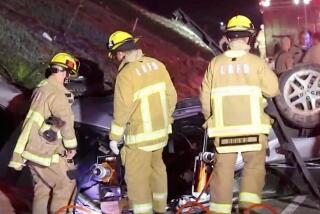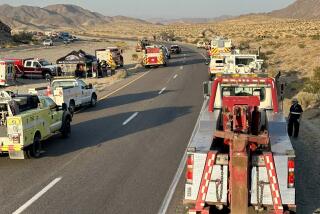‘There’s no escape route’
Big-rig drivers say they dread the tunnel. Some call it the worst in the state. The traffic lanes curve left toward Los Angeles and then, abruptly, the drivers find themselves in the tunnel, blinded in the dark.
“I’ve been driving 23 years, and I hold my breath every time,” said truck driver Fausto Evangelista, 42, as he weighed his big rig at a Commerce traffic stop Saturday night.
“You don’t see what’s ahead until you get in the tunnel,” said another trucker, Luis Ceja, 49, of Norwalk, who estimates he has been through the I-5 tunnel more than 100 times.
“It’s like you’re going blind,” Ceja said. “The tunnel’s so dark -- you only have a second to react.”
Veteran truck drivers say the treacherous 550-foot-long tunnel near Santa Clarita mixes three of the problems they dread most -- darkness, blind spots and curves. While authorities say they do not yet know what caused the Friday night accident, big-rig drivers said they were not surprised that the collisions occurred there.
Trucks are much harder to drive than cars, making such hazards even tougher to navigate.
“Obviously they’re bigger. When they crash, they do a lot more damage, they’ve got a lot more weight behind them,” said Jason Hurd, an inspector with the Los Angeles County Fire Department.
The sheer height and weight of container trucks make them more likely to tip on curving freeway entrance and exit ramps, especially those built in the 1950s and 1960s. It also takes much longer to stop a truck than a passenger car.
Veteran truck drivers said Saturday that the tunnel near Santa Clarita is notorious among those who frequent the I-5 corridor.
The southbound I-5 truck tunnel can be treacherous in the rain, said Evangelista, who drives for Rapid Transfer Express and was headed for San Diego on Saturday night.
According to Bill Hoffer, a spokesman for the National Weather Service, a slight rain began falling in the Santa Clarita area Friday afternoon.
“When it rains, the water won’t evaporate,” Evangelista said. “It’s a lake of oil and water, and it’s real easy to slide on it,” he said, shouting over the roar of his big rig. This is the worst time of year for those conditions, he said, before the rainy season begins. “When you’re going fast, right after it rains, you’re not giving yourself a chance.”
He agreed that the curve on the tunnel approach is treacherous: “The curve plays a big role, too. If you’re going too fast, you’re dead meat.”
“I always have an escape route in mind, but tunnels are the worst, because there’s no place to go. There’s no escape route,” said Robert Griffin, 32, of Watts, who was filling his big rig with fuel in Commerce before heading to Washington, D.C., with a load of frozen cookie dough.
Griffin tries to keep his distance from other vehicles when he drives, and he’s even more nervous when he enters a tunnel.
“It’s easy to wreck there. It’s not so much the truck. It’s what other people are doing in the tunnel,” Griffin said. “You have to use a lot of common sense.”
Daniel Alvarez, 34, of Dallas, who drives for New World Logistics, said other truck drivers have warned him about the tunnel curve and the blind spot it creates.
“The bad thing about that tunnel is that if there’s a problem in the front, it’s going to affect everyone afterwards. If there is a crash or someone stops, the next guy is not going to see it,” said Alvarez as he purchased disposable razors and a Monster energy drink at the Commerce Truck Stop before driving north toward Fresno.
More and more big rigs have flooded Southern California freeways as the Los Angeles-Long Beach ports have grown with expanding global trade to become the world’s fifth-largest port complex. About one-third of port cargo is shipped by rail, but most of the rest goes by truck, clogging area freeways and increasing the likelihood of collisions.
Truck drivers make safety their highest priority, said Julie Sauls, vice president of external affairs at the West Sacramento-based California Trucking Assn., which represents more than 2,300 trucking firms and related industries statewide.
“They try to do what they can to drive as safely as possible,” Sauls said Saturday. “But obviously, not all conditions are under their control.”
S. David Freeman, president of the Los Angeles Board of Harbor Commissioners, said the accident is a reminder of the dangers of truck travel.
“We just need to get more and more of this traffic off the trucks and onto a 21st-century version of what used to be called railroads,” Freeman said Saturday.
“It’s not safe out there on those highways today, and it takes a big accident to bring this to people’s attention.” Freeman said the port is trying to devise safer means of transporting freight.
Truck drivers who are paid by the load can be under pressure to deliver their cargo before a warehouse or port terminal closes, adding to the stresses of freeway driving -- and the desire to move fast, Ceja said.
“These drivers, they’re in a hurry to make the second delivery,” he said. “They shouldn’t drive in a hurry, they shouldn’t drive with the pressure.”
Ceja said he nearly hit a car in the southbound I-5 tunnel and now takes care to approach it at 10 to 15 mph. The speed limit in the tunnel is 55 mph, highway officials said Saturday.
“When you’re driving something this big,” Evangelista said, “it doesn’t take much for things to go wrong.”
jason.song@latimes.com
--
Library researcher John Tyrrell contributed to this report.
More to Read
Sign up for Essential California
The most important California stories and recommendations in your inbox every morning.
You may occasionally receive promotional content from the Los Angeles Times.










